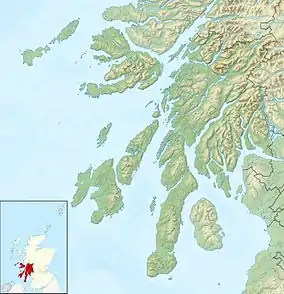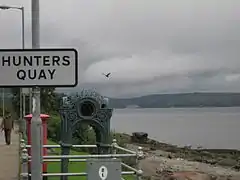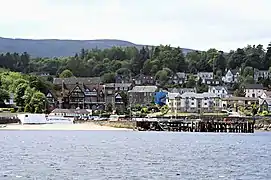Hunters Quay
Hunters Quay (Scottish Gaelic: Camas Rainich) is a village, on the Cowal peninsula in Argyll and Bute, Scottish Highlands. Situated between Kirn to the south and Ardnadam to the north, Hunters Quay is the main base of Western Ferries, operating between Hunters Quay and McInroy's Point.
Hunters Quay
| |
|---|---|
.jpg.webp) Hunters Quay viewed from the Firth of Clyde, looking southwest | |
 Hunters Quay Location within Argyll and Bute | |
| Population | 5,198 (2013 Est) Including; Kirn, Hunters Quay and Sandbank.[1] |
| OS grid reference | NS 18396 79130 |
| Council area |
|
| Lieutenancy area |
|
| Country | Scotland |
| Sovereign state | United Kingdom |
| Post town | DUNOON, ARGYLL |
| Postcode district | PA23 |
| Dialling code | 01369 |
| UK Parliament |
|
| Scottish Parliament |
|
Structures
Royal Marine Hotel
The current building was built in 1890. This and the previous building was, between 1872 and the 1950s, the home of the Royal Clyde Yacht Club, which was founded in 1856.
Villas
In the mid 19th century, the principal villas at Hunters Quay were Claver House (Mr Miller), Linnwood (Mr Somerville), Rock Hill (Capt. Littlejohn), Whinhill (Mrs Ross), Woodside (Mr Bell) and Craigend (Mr Bryson).[2]
1908 Summer Olympic Games
The 12-metre class yacht race in the 1908 London Olympic Games took place at Hunters Quay. Most of the sailing took place on the Solent, but only two boats entered the 12-metre class: Mouchette from the Royal Liverpool Yacht Club and Hera from the Royal Clyde Yacht Club. They were allowed to race on the Clyde for convenience. The course was twice round a 13-mile (21-kilometre) lap of the Clyde, starting and finishing at Hunters Quay. Thomas C. Glen-Coats' Hera won.
Jim Crow Rock

"Jim Crow" (earlier "The Jim Crow"),[3] a pointed glacial erratic rock lying horizontally on the beach, was known as the "Jim Crow Stone" in the 1880s,[4] and by 1904 was painted with a face. The inspiration behind the name and design have been suggested to be: the Jump Jim Crow song and dance popularised by the American minstrel show performer Thomas D. Rice; local stories suggest it could have been the name of the owner of a nearby builders’/joiners yard; a jackdaw [which has a black beak but not a red mouth]; or the Jim Crow laws which were state and local laws enforcing racial segregation in the Southern United States. Due to this potential link the rock has been painted over a number of times, but always returned to its original state.[5] Another is that it is named after the line "So they canonized him by the name of Jim Crow!" in the poem The Jackdaw of Rheims.[6]
The Jim Crow Rock was sandblasted back to bare rock in 2020.[7]
Gallery
 A view of the Holy Loch, looking northwest towards Kilmun.
A view of the Holy Loch, looking northwest towards Kilmun. The Royal Marine Hotel is the half-timbered building.
The Royal Marine Hotel is the half-timbered building. Hunters Quay viewed from Cloch Point.
Hunters Quay viewed from Cloch Point. A Western Ferries ferry approaching the quay.
A Western Ferries ferry approaching the quay.
References
- "Intermediate Zone: Hunter's Quay". Scottish Government. Retrieved 11 May 2018.
- Colegate's Guide to Dunoon, Kirn, and Hunter's Quay (Second edition) - John Colegate (1868), page 28
- "A photo of The Jim Crow, taken around 1900". Archived from the original on 9 August 2016. Retrieved 16 February 2016.
- Bell, Dugald (1885). "Gourock and the Cloch". Among the Rocks Round Glassgow: A Series of Excursion-sketches and Other Papers. J. Maclehose & sons. p. 154.
- "Dunoon rocked by racism row". The Scotsman. 22 July 2011. Retrieved 16 February 2016.
- https://rpo.library.utoronto.ca/poems/jackaw-rheims Full text of The Jackdaw of Rheims
- "Dunoon's racist 'Jim Crow' rock is set to be scrubbed". The National.
| Wikimedia Commons has media related to Hunters Quay. |